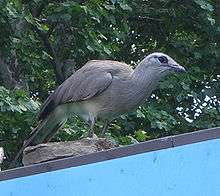Black-legged seriema
| Black-legged seriema | |
|---|---|
 | |
| Scientific classification | |
| Kingdom: | Animalia |
| Phylum: | Chordata |
| Class: | Aves |
| Order: | Cariamiformes |
| Family: | Cariamidae |
| Genus: | Chunga |
| Species: | C. burmeisteri |
| Binomial name | |
| Chunga burmeisteri (Hartlaub, 1860) | |
The black-legged seriema (Chunga burmeisteri) is one of two living species of seriemas in the family Cariamidae. It is found in Argentina, Bolivia, and Paraguay. Its natural habitats are subtropical or tropical dry forests and subtropical or tropical dry shrubland.
Behaviour
The black-legged seriema is similar to its relative, the red-legged seriema, Cariama cristata. However, the black-legged seriema is more arboreal than its cousin, and it prefers to spend more time in trees. They often live together in family groups, and hunt prey together.
Hunting and diet
Seriemas are omnivorous. In the wild, they prey on rodents, birds, insects, and reptiles, such as lizards and snakes. They supplement this diet with some plant material, too. They have a large, curved, and hyperextensible claw on the second digit of each hind foot. This claw resembles that of the ancient deinonychosaurian dinosaurs, such as Troodon. If a piece of food is too large to be swallowed whole, the seriema will cut it apart with the sickle-claw. This claw is also used to kill prey, and climb trees.
Relationship with humans
Farmers in South America often capture young seriemas from the wild, and tame them. They are then trained to guard the farm against potential predators, such as foxes.
Seriemas are very fierce, and they have been known to attack humans, especially when defending their young.
References
- ↑ BirdLife International (2012). "Chunga burmeisteri". IUCN Red List of Threatened Species. Version 2013.2. International Union for Conservation of Nature. Retrieved 26 November 2013.
